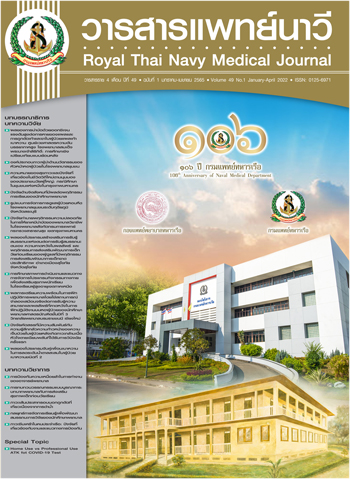การป้องกันความเหนื่อยล้าในการทำงานของอาจารย์พยาบาล
Main Article Content
บทคัดย่อ
ความเหนื่อยล้าในการทำงานเป็นผลมาจากความเครียดที่สะสมมาเป็นระยะเวลานาน พบมากในกลุ่มบุคลากรด้านสาธารณสุข เนื่องจากภาระงานที่หนักและลักษณะงานที่ก่อให้เกิดความเครียดและความกดดัน บุคคลที่เกิดความเหนื่อยล้าในการทำงานจะแสดงออกด้วยอาการ 3 ด้าน คือ ความอ่อนล้าทางอารมณ์ การลดค่าความเป็นบุคคล และความรู้สึกไม่ประสบความสำเร็จในการปฏิบัติงาน ทำให้ขาดแรงจูงใจและความสนใจที่จะทำหน้าที่ตามบทบาทที่ตนเองได้รับอย่างเต็มที่ ส่งผลให้ประสิทธิภาพการทำงานในองค์กรลดลง และนำไปสู่การลาออกจากงานในที่สุด การป้องกันความเหนื่อยล้าในการทำงานสามารถป้องกันได้ทั้งในระดับบุคคลและองค์กร ซึ่งจะช่วยให้บุคคลเกิดความมุ่งมั่นตั้งใจ มีเป้าหมาย และมีความสุขในการทำงาน ส่งผลให้การทำงานมีประสิทธิภาพเพิ่มมากขึ้น และบรรลุวิสัยทัศน์ขององค์กร บทความนี้มีวัตถุประสงค์เพื่อนำเสนอเกี่ยวกับความหมายของความเหนื่อยล้าในการทำงาน ปัจจัยที่เกี่ยวข้องกับความเหนื่อยล้าในการทำงาน อาการแสดงของความเหนื่อยล้าในการทำงาน ผลกระทบจากการเกิดความเหนื่อยล้าในการทำงาน ระยะในการทำงานซึ่งนำมาสู่ความเหนื่อยล้าในการทำงาน การประเมินและการป้องกันความเหนื่อยล้าในการทำงาน
Article Details

อนุญาตภายใต้เงื่อนไข Creative Commons Attribution-NonCommercial-NoDerivatives 4.0 International License.
เอกสารอ้างอิง
Maslach C, Jackson SE. Burnout in health profession: a social psychological analysis. In: Sanders GS, Suls J, editors. Social psychology of health and illness. San Francisco: L. Erlbaum Associates; 1982. p. 227-51.
Maslach C. Burnout: the cost of caring. Englewood Cliffs: N.J. Prentice Hall; 1982.
Youngsri C. Perception of working environment: burnout and turnover intentions of employees. Bangkok: Industrial and Organizational Psychology King Mongkut’s Institute of Technology North Bangkok; 2006. (in Thai).
Ames SE, Cowan JB, Kenter K, Emery S, Halsey D. Burnout in orthopedic surgeons: a challenge for leaders, learners, and colleagues: AOA critical issues. J Bone Joint Surg Am 2017;99(14):e78.
Jearong K, Srivichai C. Relationship between working environment factors and burnout of nurses, community hospital of Pathumtani province. Journal of The Royal Thai Army Nurses 2017;18(Suppl2):299-305. (in Thai).
Putra KR, Setyowati S. Prevalence of burnout syndrome among nurses in general hospitals in provincial East Java: cross-sectional study. Enferm Clin 2019;29(Suppl2):362-6.
Pokasem B, Chaimongkol N. Factors predicting happiness in work of nursing faculties. The Journal of Faculty of Nursing Burapha University 2014;22(4):13-24. (in Thai).
Suksawan T, Sangsawang K, Rueangrit P. Relationship between work-related factors, family and social-related factors and burnout of nurse lecturers in Boromarajonani College of Nursing in northern region under supervision of Praboromarajchanok Institute. Journal of Health Science Research 2011;5(1):40-7. (in Thai).
Phaktoop M, Saradhuldhat G. Shortage and retention of nurse educators in education institutions. Journal of Nursing and Education 2018;11(3):1-9. (in Thai).
Freudenberger HJ. Staff burn-out. J Soc Issues 1974;30:159-65.
Potter BA. Preventing job burnout. Illinois: Crip Publications; 1997.
Sereesitthipitak V. Burnout: definition, inventory, prevention and intervention. Journal of Somdet Chaopraya Institute of Psychiatry 2007;1(2):121-30. (in Thai).
Summawart S. Burnout of staff nurses at Ramathibodi Hospital. [Master’s Thesis, Faculty of Nursing]. Mahidol University; 1989. (in Thai).
Yongcharoen P, Sithisarankul P. Prevalence and associated factors of burnout syndrome among ship officers of the Royal Thai Navy. Royal Thai Navy Medical Journal 2020;47(1):204-22. (in Thai).
Leelukkanaveera Y, Longphimai C, Toonsiri C. Influencing factors of stress among the Royal Thai Navy in Narathiwat province. Royal Thai Navy Medical Journal 2018;45(2):399-416. (in Thai).
Cooper C, Cartwright S. An intervention strategy for workplace stress. Journal of Psychosomatic Research 1997;43(1):7-16.
Maslach C, Leiter MP. The truth about burnout: how organizations cause personal stress and what to do about it. San Francisco: Jossey-Bass; 1997.
Maslach C, Jackson SE. The measurement of experienced burnout. Journal of Organizational Behavior 1981;2:99-113.
Mealer M, Moss M, Good V, Gozal D, Kleinpell R, Sessler C. What is burnout syndrome (BOS)? Respir Crit Care Med 2016;194(1):1-2.
Muldary TW. Burnout and health professionals: manifestations and management. San Jaun Capistrano, CA: Capistrano Press; 1983.
Miller LH, Smith AD, Rothstein L. The stress solution: an action plan to manage the stress in your life. New York: Pocket Books; 1993.
Maslach C, Jackson SE. Maslach burnout inventory manual. 2nd ed. Palo Alto, CA: Consulting Psychologists Press; 1986.
Suteerawut N. Burnout: antecedents and prevention. Journal of Education Measurement 2015;32(91):16-25. (in Thai).
Cheaplamp S, Dangdomyouth P. Burnout syndrome. Royal Thai Air Force Medical Gazette 2019;66(2):44-52. (in Thai).
Yee BH, Duxbury LE. The dynamics and management of burnout: nursing management. Minnesota: Minnesota Evidence-based Practice Center; 1981.


